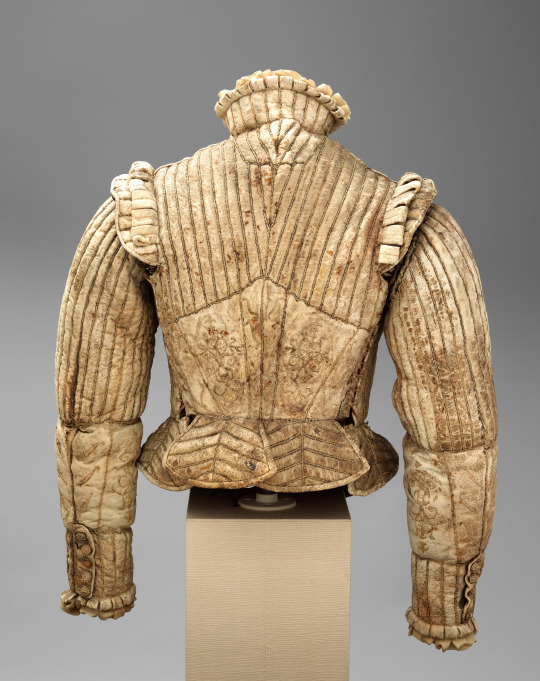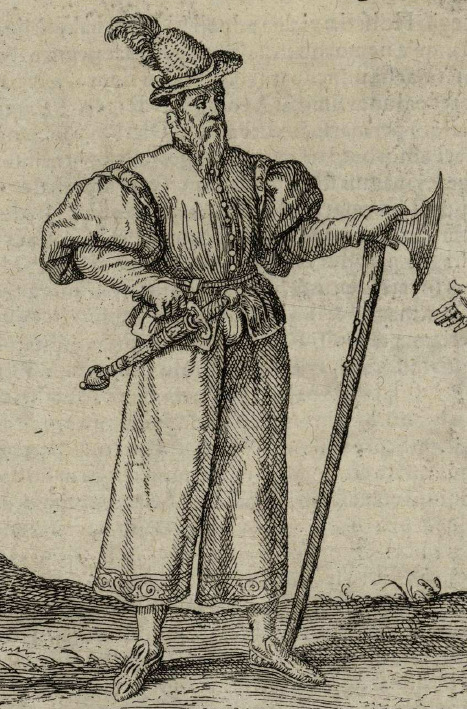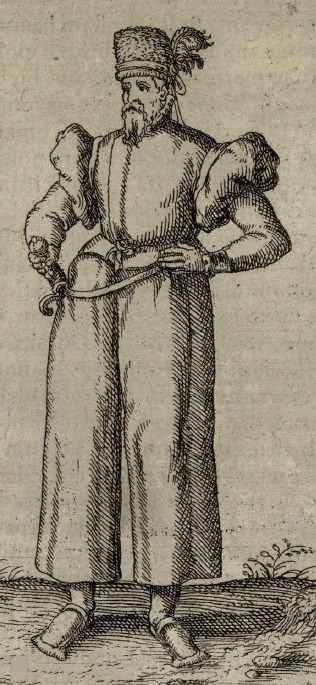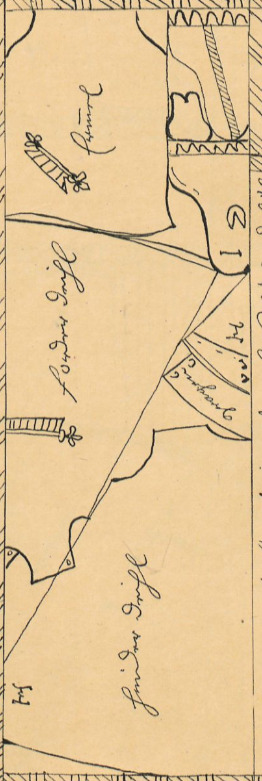Me obsessing about clothing between 1500 and 1700.Mid 20s - European - he/him
Last active 60 minutes ago
Don't wanna be here? Send us removal request.
Text


Doublet of silk and velvet, early 17th century (?) This doublet was made of red velvet (now turned brown) and a silk brocade, which was used for the sleeves. Several silk bows are attached to lacing holes inside the waist tabs - while they could´ve been used to attach the doublet to a pair of breeches, these bows seem to have been mainly decorative. As it was fashionable in the first half of the 17th century, the doublet front is stiffend below the chest, creating a very tight fit around the belly.
The doublet was recently sold for £11,500 - a huge sum, given the fact that the provenance of this garment is still unknown. As there are some features that are quite unusual for 17th century doublets, it´s still disputed if it´s an actual 17th century garment - or if it was heavily altered (or even made) later. For example, the sleeves are made of a different material than the body - which is a popular choice for later costume pieces, but rarely found among actual garments from that time period.
As there are several well made 19th century costume pieces based on 17th century fashion, it´s not always easy to determine if a garment is genuine or not. Photos by Dominic Winter Auctioneers, doublet sold to private buyer.
178 notes
·
View notes
Text

Spanish-style cape, late 16th/early 17th century This half-circle cloak was made of twill weave wool and heavily embroidered. It is unlined, but a pointy hood was added to shield the wearer from wind and rain. Even though provenance and purpose of this cape are still unknown, the embroidered hood indicates that it was made in Spain - or at least in the Spanish style. While hoods were a common feature of Early Modern garments, heavily embroidered hoods were considered to be typical for Spanish fashion and thus appear in several tailor´s books. Exhibited at the Germanisches Nationalmuseum in Nürnberg, Germany.
#historical fashion#historical costuming#fashion history#history#16th century#16th century fashion#17th century fashion#17th century#early modern history#early modern art#renaissance fashion
121 notes
·
View notes
Text




English linen ruff, early 17th century This ruff, believed to have been owned by London lawyer Edwin Rich (1590s-1675), was recently auctioned off fo 299.000£. The reason for this high price is the rare finish at the outer edges of the ruff; instead of having a rolled or folded hem, the raw edges were just left to fringe, creating a distinct look that can only be observed in a couple of portraits and very few extant examples. Ruffs were a wide spread accessoire during the late 16th and early 17th century, as both men and women enjoyed adding different styles of ruffs to their wardrobe. The ruffs would be starched and then sewn or laced to the collar of a doublet/gown. While they were made of fine linen and not cheap, Edwin Rich might have been surprised by the incredible amount of money his ruff would be worth centuries later. Photos by Kerry Taylor auctions - the ruff was sold to a private buyer.
#historical fashion#historical costuming#fashion history#history#renaissance#16th century#16th century fashion#17th century fashion#17th century
105 notes
·
View notes
Text

Burial garments of Count Anton Günther of Oldenburg (1583 - 1667) When Anton Günther died in 1667, his body was placed in a wooden coffin with a small glass window - so that his grieving subjects could say goodbye to their beloved Count. He was buried in clothes he had already worn in life: a pair of breeches and a short gown, which had been cut open at the back - making it easier to dress the corpse. Years later, people who visited his crypt could still see the rotting corpse of the Count through the glass window in his coffin. Later on, thiefs smashed the window to steal the silver buttons on the Count´s garments. Still, the garments managed to survive the centuries and were extracted from the coffin in the 20th century. Today, they are exhibited at the Oldenburg castle. Breeches and gown are exhibited at the Oldenburg Castle, Germany.
#historical fashion#historical costuming#fashion history#history#16th century#16th century fashion#17th century fashion#17th century#baroque fashion#baroque
27 notes
·
View notes
Text



Linen underwear from Italy, late 16th/early 17th century The use of underwear changed greatly during the 16th and 17th century. As mens´ Hose were extremely tight fitting in the early 16th century, men wore equally tight fitting linen briefs - while the upper body was covered with a linen shirt. In the second half of the 16th century, fashion had changed - most men wore wide and baggy breeches now. Instead of wearing underpants, many of them just tucked the ends of their long shirts between their legs, omitting any kind of underwear. Only those who still wore tight fitting Hose (as many farmers and riders did) had need for additional underwear. Things changed again in the early 17th century, when men slowly started to wear underbreeches again - this time, they were long and full, mimicking the shape of the baggy breeches worn on top. As far as we know, linen was the only fabric used for these underbreeches. As they had to be comfortable and washed frequently, no other fabric was suited. Still, some men wore woolen underbreeches on top of their linen counterparts when weather was too cold. For women, matters were even easier - most didn´t own any kind of underpants at all and just wore linen smocks and shirts. Just like the men, they simply had no need for additional underwear. Still, there are sources indicating that some women wore embroidered underbreeches as a fashionable accessoire and for additional comfort. This post was kicked off by the kind request of @pourpasserlamelancholie, who asked about underwear and women´s fashion. More posts about women´s fashion will follow soon! Italian underwear stored at the MET in New York, USA.
#historical fashion#historical costuming#fashion history#renaissance#renaissance fashion#history#16th century#16th century fashion#17th century fashion#17th century
84 notes
·
View notes
Text


Cassock, doublet and breeches of Gustav Adolf II. of Sweden, ca. 1620 This suit was ordered in 1620 for the wedding of King Gustav II. Adolf of Sweden. The pieces were prepared in Hamburg and then shipped to Sweden, where they were assembled at the King´s court. While cassock and breeches are made of wool, the doublet is made of silk satin. The whole suit is embroidered with golden yarn and decorated with spangles and trim. As it was fashionable in the early 17th century, the doublet front had a curved waist that ended in a pointy front - which was then mirrored by the waistband of the breeches, wich was also slightly pointy. Exhibited at the Livrustkammaren in Stockholm, Sweden.
#historical fashion#historical costuming#fashion history#renaissance#renaissance fashion#history#17th century fashion#17th century
290 notes
·
View notes
Note
Would you kindly help me? I want to know what sort of suit Howl wears in the book Howl's Moving Castle. It is described as blue and silver with long trailing sleeves with scalloped edges and Sophie cuts it up so it's only a silver net. The most efficient ways of transportation in the book are by magical means (flying carpets, seven-league boots) but there is advanced plumbing with hot and cold water on demand and has been for a while at least.
Is there any historical outfit that matches ; what era would it be from?
That´s a super interesting question! It might be a Houppelande, a very popular garment from the 14th and 15th century. In this case, it would be checkered one in blue and silver. The combination of scalloped edges and trailing sleeves definitely sounds like a late Medieval garment to me. I´m not an expert on (late) medieval fashion though, but I still hope my answer helps!
#historical fashion#historical costuming#fashion history#medieval#medieval fashion#howls moving castle
17 notes
·
View notes
Text


Suit of Elector Johann Georg I. of Saxony, 1620s This suit, once owned by Saxon Elector Johann Georg, is not only quite beautiful - it´s also very special. The doublet is one of the very few 17th century garments with sleeves made of a different fabric than the body. While most of the doublet is made of green velvet, the sleeves are made of silk satin, embroidered and decorated with spangles. Other aspects of this suit are typical for early 17th century fashion - like the loop at the back waist, meant to hold a belt in place. Two small holes at the back of the collar were meant to secure a ruff, which would be tied to the collar with laces. Exhibited at the SKD in Dresden, Germany.
#historical fashion#historical costuming#fashion history#renaissance#history#17th century#17th century fashion#renaissance fashion
67 notes
·
View notes
Text


Padded leather doublet, late 16th century This embroidered leather doublet (or jerkin) is often times classified as a "fencing doublet" - which is not surprising, given the fact that this garment is not only made of sturdy materials, but also heavily padded. The tie-in sleeves and the laced side openings also make the doublet look like it´s supposed to be a practical piece of sportswear. Unfortunately, there isn´t any proof for the existence of protective fencing jackets in the 16th century. Tournaments were fought without any protection (except gloves, in some cases), while fencing practice was generally done wearing "normal" everyday clothes. So if it´s not a fencing jacket, what was this doublet used for? Actually, nobody knows for sure. It might have been a hunting garment or used for military purposes - or perhaps the wearer just wanted to wear an embroidered leather doublet. Exhibited at the MET in New York, USA.
#historical fashion#historical costuming#fashion history#renaissance#renaissance fashion#history#16th century#16th century fashion
231 notes
·
View notes
Text

Woolen suit of the murdered Christoff Schmeltz, ca. 1639 In 1896, several bodies were discovered during the renovation of the church in Elgg, Switzerland. One of the bodies was dressed in this suit, consisting of leather shoes, woolen stockings, breeches, a doublet and a velvet cap. Now of brownish colour, the garments might have been black or even red originally. As the clothes were described as covered in thick layers of blood at the time of their discovery, scholars assumed that the men buried in the church of Elgg must have died a violent death. It´s possible that the deceased was an Officer named Christoff Schmeltz, who was stabbed during a drunken quarrel in 1639. Schmeltz, who felt offended by another man´s broken sword, challenged the man to a duel, just to be fatally stabbed shortly after. Even though the identity of the body can´t be proven, he left behind an incredibly fashionable suit - and a thrilling story about his (alleged) death. Suit exhibited at the Schweizerisches Nationalmuseum in Zürich, Switzerland.
#historical fashion#historical costuming#fashion history#renaissance#renaissance fashion#history#16th century fashion#17th century fashion#17th century#16th century#swiss history
492 notes
·
View notes
Text



Draft and fabric sample for a bridesmaids´ dress, 1566 When Wilhelm IV. von Hessen-Kassel and Sabina von Württemberg got engaged in 1565, preparations for the wedding started immediately. As part of the preparations, these pages containing drafts and fabric samples were sent to the Hessian court. They were meant to be used as a guidline, ensuring that both noble families dressed their bridesmaids in the same colours and garments. It´s incredibly rare for 16th century drawings to survive together with their corresponding fabric samples, which makes this extant example even more exciting. Pages from: https://ausstellungen.deutsche-digitale-bibliothek.de/mode-in-hessen/#s9
#historical fashion#historical costuming#renaissance#fashion history#history#renaissance fashion#16th century#16th century fashion#silk dress
206 notes
·
View notes
Text

Rider in service of the Electoral Palatinate, late 16th century While uniforms weren´t particularly wide spread during the 16th century, many men serving the Lords and cities of the Holy Roman Empire were equiped with garments that would symbolize their position in some way. This rider, dressed in black Hose and a black riding gown, has an elaborate emblem stitched to his left sleeve. These emblems commonly incorporated either the colours or the motto of the person or institution the wearer was serving. This way, rank and allegiance of the Servant were visible to everybody. Picture from: https://ausstellungen.deutsche-digitale-bibliothek.de/mode-in-hessen/items/show/6
#historical fashion#historical costuming#fashion history#renaissance#renaissance fashion#history#16th century#16th century fashion
31 notes
·
View notes
Text



Soldier and civilians from Dithmarschen, 1590s Clothing in the 16th century was not only influenced by fashion and personal taste - often times, it also had to be practical. Many men from coastal regions all over Europe wore wide breeches that could easily be rolled up if the ground was too wet or muddy. That obviously didn´t mean that these breeches weren´t supposed to be fashionable - as these men from the Dithmarschen region (try to) prove. Depictions from: "Urbium Praecipuarum Mundi Theatrum Quintum" by Georg Braun, approx. 1596(?)
#historical fashion#historical costuming#fashion history#renaissance#renaissance fashion#history#16th century#16th century fashion
38 notes
·
View notes
Text





Revisiting one of my favourites: Silk doublet of Duke Moritz of Sachsen-Lauenburg (1551-1612) As my original entry about this doublet continues to be one of my most popular posts, I decided to write an updated version shining a light on its construction and use. When this doublet was listed right after the Duke´s death in 1612, it was called a "Sommerwams" or summer doublet. This name most likely referred to the construction: as it´s mostely just made of thin satin and linen (and elaborately slashed), it was the perfect choice for hot summer days. As green garments with huge sleeves were also a popular choice for riding and hunting, there is a high chance that the Duke used his doublet for this purpose. The only reinforced parts of the doublet are the collar (which was stiffened with coarse linen) and the peascod belly, which was padded with cotton. Also, dense wool was used to reinforce the fabric around the button holes and under the skirts. The doublet is not only adorned with several yards of metallic trim, but also with decorative silk bows placed around the waist. While they mimic ties used to connect the doublet to the breeches, they are completely decorative; doublet and breeches were connected with metal hooks and eyes. A hidden pocket in the left sleeve could´ve been used to store personal belongings. While the Duke preferred gilded silver buttons on his other doublets, his summer doublets are made with silk-covered buttons made of wood. As the garment is very lightweight, heavy metal buttons would´ve put too much stress on the thin fabric. Stored at the Historisches Museum Hannover.
#historical fashion#historical costuming#fashion history#renaissance#renaissance fashion#history#16th century#16th century fashion#17th century fashion#17th century#silk satin
207 notes
·
View notes
Text



Patterns for riding gowns, late 16th (or early 17th) century As people still go crazy about the beautiful riding gown from Saxony I posted some time ago, I decided to share some period patterns for similar garments. These patterns are from a later copy of the Schwabach pattern book and were most likely used for training and testing the members of the Schwabach tailor´s guild. While these patterns are not to scale, they can still serve as a starting point if you want to make your own 16th century riding gown. Schwabach pattern book: https://digishelf.de/objekt/77488794X/19/ Top photo: Riding gown exhibited at the SKD Dresden, Germany
#historical fashion#historical costuming#renaissance#renaissance fashion#fashion history#history#16th century#16th century fashion#17th century fashion#17th century
189 notes
·
View notes
Text

Silk doublet from the Hüpsch collection, 1660s - 70s This doublet was once part of the costume collection of the mysterious Baron von Hüpsch (1730-1805). The self proclaimed Baron spent his days studying, surrounded by thousands of historical artifacts he hoarded in his house in Cologne. Even though he was a fraud, this doublet is one of the few examples of late 17th century fashion - and most likely only survived because of him. The doublet is made of ribbed silk and lined with a blend of hemp and cotton. To close it, silk covered buttons were used. As the doublet is cut away at the front to reveal the wearers shirt, all button holes below chest level are fake. The sleeves, just reaching slightly below the elbows, are heavily decorated with silk bows. The collar is heavily stiffened and slightly pointy at the front; like the doublet body, it closes with buttons, but instead of button holes, loops are used. While the eyelet holes around the waist might have been used to tie the doublet to a pair of breeches, chances are high that they were purely decorational at this point. Stored at the Hessisches Landesmuseum in Darmstadt, Germany.
#historical fashion#historical costuming#fashion history#history#17th century fashion#17th century#baroque fashion#baroque
63 notes
·
View notes
Text



Renaissance fashion myth-busting: The Codpiece The codpiece is a part of 16th century fashion that looks weird to many modern observers. While having a padded, suggestively shaped piece of fabric in front of your crotch seems inherently sexual to some people nowadays, for men in the 16th century, it was just an ordinary part of their hose and breeches. Even though we know that sexual jokes about the codpiece existed back then, there are no sources indicating that people saw them a inherently problematic. When young boys got the their first pair of hose, it might have already featured a codpiece - and when old men were buried in their last pair of breeches, there also might have been a codpiece present. It wasn´t seen as frivolous or indecent, just as a suitable sign of masculinity (which was a pretty complex topic in the 16th century). In modern times, wild myths and theories about the codpiece emerged - some which are still spread today without any historical source and evidence. For example, there is the myth that many men owned a collection of codpieces that they could just fasten to their breeches as they liked - in reality, codpieces were sewn to the breeches and could not simply be removed or exchanged. At least we have no sources indicating the opposite.
The codpieces also served a practical purpose: As they added additional fabric between the legs, they were an important part of the tight fitting hose of the early 16th century; a part that couldn´t just be removed without making the hose unwearable. And while there might have been cases of men using their codpieces as purses or pockets (another popular codpiece-myth), all extant codpieces are nothing more than fashionable, practical details on their respective breeches.
So while codpieces might look super wild and interesting to us - for people in the 16th century, they were most likely nothing interesting or special.
1. picture: Detail from Pieter Bruegel´s "De parabel der blinden", 1568. 2./3. picture: Woodcuts from Jost Amman´s Kunstbüchlin, 1590s.
#historical fashion#historical costuming#renaissance#renaissance fashion#history#fashion history#16th century#16th century fashion
67 notes
·
View notes